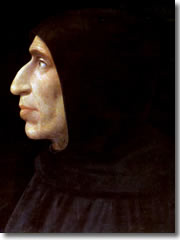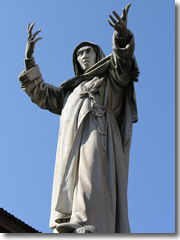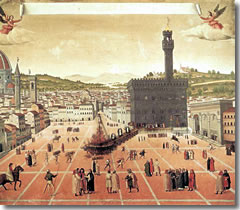- Places
- Plans
- Itineraries
- Experiences

A portrait of Fra' Girolamo Savonarola, the Mad Monk from Ferrara, by his follower Fra' Bartolomeo, now in the Museo di San Marco.Fra' Girolamo Savonarola (1452–1498) was a Dominican friar and religious fundamentalist from Ferrara who moved his ministry to San Marco in Florence in 1490 (he actually had first preached here in the 1480s, but didn't leave much of an impression).
Things were different the second time around. He preached a firebrand vision of Christianity, full of the doom and gloom of the Last Days and admonishments to abide by strict religious rules and eschew all vice and vanity to avoid being on the wrong side of the scales come Judgment Day.
It was an apocalyptic, fundamentalist, moral reductionist, my-way-or-the-highway message, bolstered by threats of punishment—both to one's soul in the afterlife and, as his power grew, to one's own body in the here and now—for those that refused to follow his exact teachings.
In short, kinda like the Taliban.
Within four years had a sizeable chunk of the city's population under his sway, and when Charles VIII of France ousted the premier Medici family in 1494, Savonarola seized the chance to step in to fill the void of unofficial city leader.
 Savonarola swiftly created a theocratic republic, with himself at its head, and began enforcing his own strict brand of religious purity upon the hapless citizens of Florence.
Savonarola swiftly created a theocratic republic, with himself at its head, and began enforcing his own strict brand of religious purity upon the hapless citizens of Florence.
He closed the taverns and outlawed gambling, singing, and dancing.
He turned crimes like sodomy, previously merely punishable by fine, into capital offenses for which the sentence was death.
Public burnings on the Piazza della Signoria became common.
Savonarola's reign quickly escalated to near Fascist levels of autocratic rule. The friar-in-chief ignored the Vatican—which was pleading with him to stop giving the church such a bad name, and soon threatening him if he didn't stop—and resorted to increasingly violent terrorist tactics to enforce Savonarola's fundamentalist interpretation of holy scripture and apply its strict rules to the daily lives of Florentines.
By the end, Savonarola was sending shock troops of children known as the "White Shirts" marauding across the city, the gangs forcing their way into people's homes at will and hauling off anything considered unholy or corrupting—fancy clothes, jewels, and makeup, fine furnishings and other extravagances, musical instruments, works of ancient (i.e. pagan) writers and poets, any art that was not of a strictly religious nature, and any other display of distinctly un-pious ostentation and wealth—in short, "vanities."
They carted the lot of it to the center of town, heaped it all into a huge pile on Piazza della Signoria, and set a torch to the pile. They called this the "bonfire of the vanities."
Even the great artist Botticelli—who, up until then, was most famous for his allegorical scenes out of pagan myth—got caught up in the religious fervor and is said to have tossed several of his paintings onto the fire to fuel the flames.
(The artist also abandoned the pagan themes of his youth—which gave us the über-famous Birth of Venus and Allegory of Spring now in the Uffizi Galleries—and spent the rest of his career churning out vapid Madonna and Child altarpieces and other works on strictly religious themes.)
Savonarola's triumph was short-lived.
By May of 1497, Pope Alexander VI had had enough of the "Mad Monk" and and his increasingly revolutionary preaching and excommunicated the rogue friar.
That not having quite done the trick, in 1498 the pope then threatened to ex-communicate the entire city of Florence en masse for continuing to protect the preacher, and demanded Savonarola's immediate arrest and execution.

The execution of Girolamo Savonarola on Piazza della Signoria, an anonymous painting of 1498 (now in Museo San Marco).The ever-pragmatic Florentines finally came to their collective senses. They promptly turned on their erstwhile zealot, stormed San Marco on April 8, and after a bloody battle, Savonarola surrendered.
He was arrested and summarily charged with a laundry list of crimes, including heresy, sedition, and false prophesy.
Florentines are also very practical, so when they spent a few weeks torturing Savonarola around to their point of view vis a vis his crimes, they were careful not to harm his right arm. That way, he could still sign the confession when they were done.
With the confession signed, all the legal loose ends were tied up. They dragged Savonarola to the very same spot on the Piazza della Signoria where he had put the torch to the city's vanities, and sent him to his eternal reward atop a bonfire of their own.
The ashes were tossed into the Arno.
Florence returned to (secular) republican rule for a while—until the Medici came back into town in 1513 to take charge once again.
Take a guided tour of Savonarola with one of our partners:
Planning your day: Florence would well be worth a week, but you can still fit a lot into just a day or three.
To help you get the most out of your limited time in the Cradle of the Renaissance, here are some perfect itineraries, whether you have one, two, or three days to spend in Florence.
Share this page
Search ReidsItaly.com